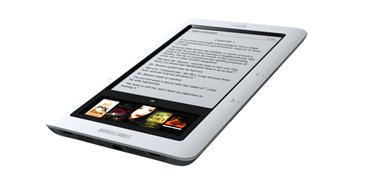Will the Nook Eat the Kindle’s Lunch?
U.S. bookseller Barnes and Noble sent a shot squarely across the bow of Amazon yesterday, with the announcement of the Nook eReader, designed to compete directly with the Kindle.
The device is built around a 6-inch display manufactured by E-Ink, whose electronic paper technology can be found in most e-readers today, including the Kindle. To differentiate itself from the competition, the Nook also sports a 3.5-inch color LCD touchscreen beneath the E-Ink display. Readers can use the touchscreen to browse their libraries, purchase books from Barnes & Noble’s ebook store (connecting via a 3G or WiFi network), or annotate books using a touch keyboard similar to the iPhone’s.

The introduction of the color display may also signal a certain impatience among users and device makers with E-Ink, which has been working on bringing color electronic paper to the market for years. The big selling points of E-Ink’s technology is that it provides large low-power displays economically that are easier to read than conventional displays. But the success of the iPhone and iPod Touch, which require frequent recharging, suggests that consumers will happily trade some battery life for more features, and are willing to spend hours viewing LCD screens, if the popularity of watching TV and movies on Apple’s mobile devices is any indication.
Not only could E-Ink face a challange from conventional mid-size LCD displays in e-readers, but other technologies are also nipping at their heels–Pixel Qi is in early production of a low-power laptop display that, like E-Ink’s displays, is easily readible even in the bright outdoors, while other companies, such as Qualcomm, are targetting the e-reader market with their alternative electronic paper technologies. “The e-reader market is accelerating quickly–this is one of the fastest growing segments the consumer electronics and mobile industries has seen in quite some time…most importantly consumers will be looking for color, multimedia capabilities and extended battery life from these devices,” says Jim Cathey, a VP of Business Development for Qualcomm. If E-Ink can’t deliver some of these color and multimedia capabilities soon, it may risk getting squeezed out of a market that it played a large part in creating.
Getting back to the Nook, it uses the Android operating system, although users cannot download and install 3rd party Android applications. However, William Lynch, president of Barnes & Noble’s website, says that “in the future, putting out a [software development kit] and a developer environment would be something exciting for us.”
The Nook also has an MP3 player for music and audio books, but does not offer a built-in text-to-speech function (as does the Kindle). Barnes & Noble claims to have rejected text-to-speech technology because, according to Lynch: “we don’t think the technology works well today. The only features that we’ve included in the Nook are features that we thought delivered a really elegant consumer experience…we think [other devices have] a fairly clumsy execution and the technology doesn’t quite deliver a great experience.” But this explanation carefully avoids the issue of, say, visually impaired consumers who might prefer even a clumsy and inelegant reading experience over no reading experience. Given that Apple, for example, has had to publicly bow to legal pressure to make their software and devices more accessible, it’s probably only a matter of time before this feature comes to the Nook.
And even though Barnes & Noble is clearly making a major brand investment in the Nook, it’s not placing all its eggs in one basket, having signed deals with e-reader makers Plastic Logic and IREX to provide content and handle transactions for their devices through Barnes & Noble’s eBook store. The company also doesn’t want readers to abandon its bricks-and-morter stores either, with a clever use of the Nook’s wireless connectivity. Consumers who bring their Nooks into a Barnes and Noble store can use the WiFi connection to avail of special deals, as well as being able to read any ebook for free while onsite, just as if they had pulled it off a bookshelf.
For me, I’m waiting with interest to see two things. First, whether or not hackers will break open the Nook’s Android platform, much as the iPhone has been hacked, and what things they will do with it if they do. Second, the response that the Nook will provoke from Amazon in the form of the next version of the Kindle. The pace of eReader development is certainly accelerating, and how the burgeoning technology will affect book and magazine publishing could be huge.
Keep Reading
Most Popular
Large language models can do jaw-dropping things. But nobody knows exactly why.
And that's a problem. Figuring it out is one of the biggest scientific puzzles of our time and a crucial step towards controlling more powerful future models.
How scientists traced a mysterious covid case back to six toilets
When wastewater surveillance turns into a hunt for a single infected individual, the ethics get tricky.
The problem with plug-in hybrids? Their drivers.
Plug-in hybrids are often sold as a transition to EVs, but new data from Europe shows we’re still underestimating the emissions they produce.
Stay connected
Get the latest updates from
MIT Technology Review
Discover special offers, top stories, upcoming events, and more.